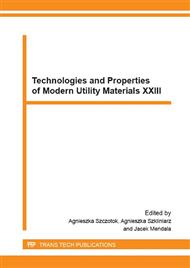[1]
H. Cuvalci, H. Bas, Investigation of the tribological properties of silicon containing zinc-aluminum based journal bearings, Tribol. Int. 37 (2004) 433-440.
DOI: 10.1016/j.triboint.2003.10.006
Google Scholar
[2]
J. Mendala, Influence of the cooling method on the structure of 55AlZn coatings, IOP Conference Series – Mater. Sci. Eng. Vol. 22, 012004, (2011).
DOI: 10.1088/1757-899x/22/1/012004
Google Scholar
[3]
P. Liberski, P. Podolski, H. Kania, A. Gierek, J. Mendala, Corrosion resistance of zinc coatings obtained in high-temperature baths, Mater. Sci+ 39, 5 (2003) 652-657.
DOI: 10.1023/b:masc.0000023504.84007.42
Google Scholar
[4]
H. Kania, M. Bierońska, Corrosion Resistance of Zn-31AlMg Coatings Obtained by Batch Hot Dip Method, Solid State Phenom. 212 (2014) 167-172.
DOI: 10.4028/www.scientific.net/ssp.212.167
Google Scholar
[5]
W. Krajewski, The Effect of Ti Addition on Properties of Selected Zn–Al alloys, Phys. Solid State+ 147 (1995) 389-399.
DOI: 10.1002/pssa.2211470210
Google Scholar
[6]
J. Mendala, P. Liberski, Liquid metal embrittlement of steel with a coating obtained by batch hot dip method in a Zn+2% Sn bath, Solid State Phenom. 212 (2014) 107-110.
DOI: 10.4028/www.scientific.net/ssp.212.107
Google Scholar
[7]
H. Kania, P. Liberski, Synergistic Influence of the Addition of Al, Ni and Pb to a Zinc Bath upon Growth Kinetics and Structure of Coatings. Solid State Phenom. 212 (2014) 115-120.
DOI: 10.4028/www.scientific.net/ssp.212.115
Google Scholar
[8]
R. Guerrero, M.H. Farias, L. Cota-Araiza, Increase in corrosion resistance of Zn-22Al-2Cu alloy by depositing an Y2O3 film studied by Auger electron spectroscopy, Appl. Surf. Sci. 185 (2002) 248-254.
DOI: 10.1016/s0169-4332(01)00825-x
Google Scholar
[9]
K. Aramaki, Synergistic inhibition of zinc corrosion in 0. 5 M NaCl by combination of cerium (III) chloride and sodium silicate, Corros. Sci. 44 (2002) 871-886.
DOI: 10.1016/s0010-938x(01)00087-7
Google Scholar
[10]
R. Michalik, H. Woźnica, Structure and Corrosion Resistance of Cast ZnAl40Cu2 Alloy, Defect Diffus. Forum 326-328 (2012) 555-560.
DOI: 10.4028/www.scientific.net/ddf.326-328.555
Google Scholar


